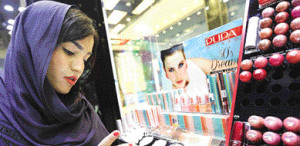July 11, 2014

You’d probably never guess it, but Iran is the seventh largest market for cosmetics in the entire world, despite being only the 18th most populous country.
Agence France Presse (AFP) reports Iran is, however, only the second largest market for cosmetics in the Middle East, behind Saudi Arabia, which has a smaller population and is the other country where women are required to cover up.
Do restrictive laws mandating that women wear shapeless clothing perhaps encourage them to make up their faces in compensation?
The cosmetics fervor in Iran is not just marginally greater than elsewhere. AFP quoted makeup professionals as estimating that Iranian women buy about one tube of mascara per month, dwarfing the one every four months bought by French women.
“Iranian women wear makeup as soon as they get up in the morning. Even if they feel ill, they know that they must look beautiful in the street,” Tina Zarinnam, 30, a fashion designer, told AFP.
The French luxury brand Lancome recently announced a return to Iran after decades away, inviting around 400 industry types and artists to one of the biggest hotels in Tehran to celebrate its comeback.
It was the first time since the 1979 Islamic revolution that a major Western brand—Lancome is the number one luxury line of the L’Oreal group—had been launched with such fanfare.
No American cosmetics brands have been sold on the official Iranian market since the US imposed a trade embargo in 1995.
The propensity for putting on dollops of makeup comes despite the fact that the regime discourages the use of lots of cosmetics. Some women have been arrested for excessive makeup, but most attention is focused on uncovered hair and tight clothing rather than makeup.
Makeup is not banned, however, and Lancome is represented in Iran by the Safir perfume chain, an official distributor of beauty products. Created in 2010, the chain now has nearly 20 branches across the country.
“It’s a booming market, which is roughly several hundred million dollars,” a brand representative told AFP, adding that this amount is split between its own distribution and the grey market.
Only 40 percent of Iran’s market is controlled by official distributors. The rest is divided among bootleggers who operate in bazaars and small shops that import cosmetics and makeup illegally, says Pegah Goshayeshi, Safir’s chief executive.
Imports are costly as regulations are strict, tariffs high and government officials must approve a product before it is licensed for sale.
Tastes in makeup vary in different parts of the country. In northern Iran, colored mascara and perfumes with a flowery fragrance are preferred, while women in the south tend to buy black mascara and stronger, muskier perfumes.
Iranian men are also gradually leaning toward using more cosmetics. “They take better care of their skin, because they want to look younger,” Goshayeshi said.
